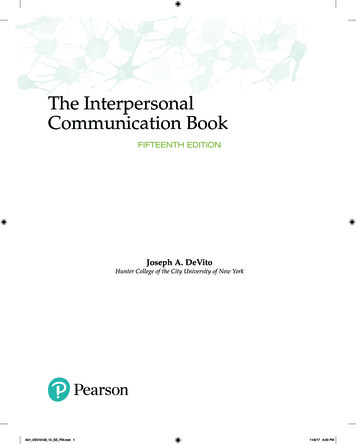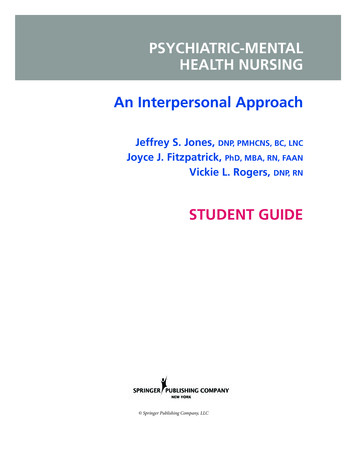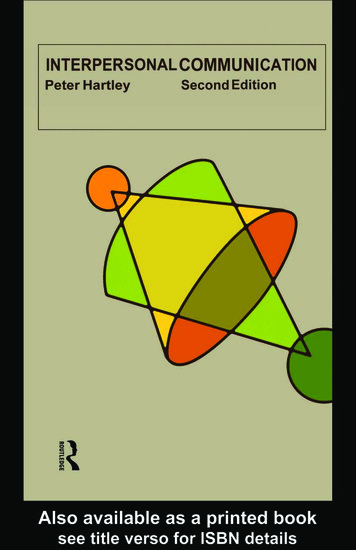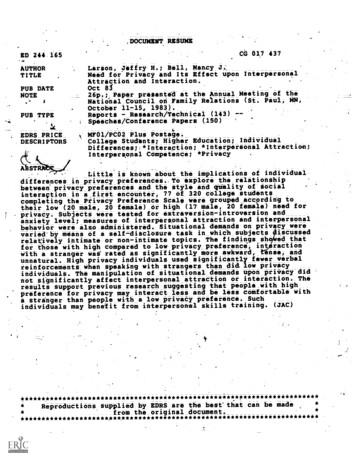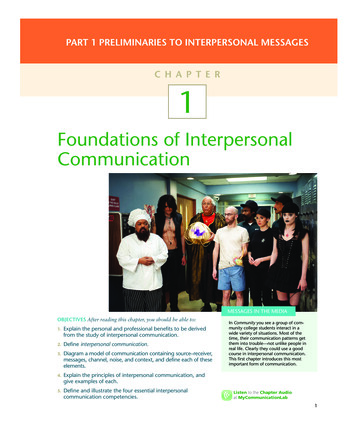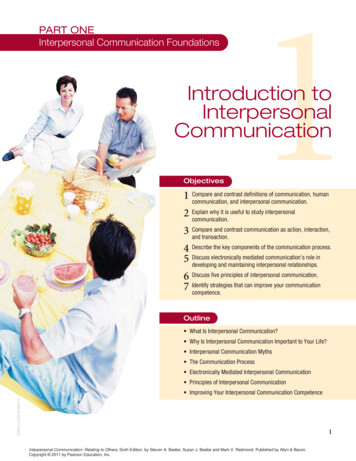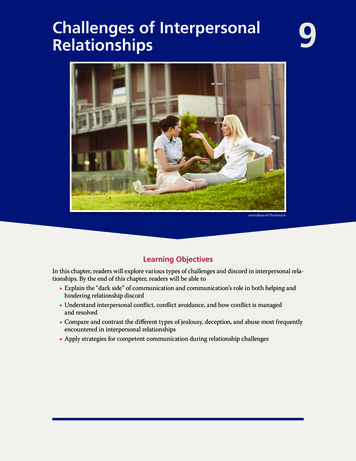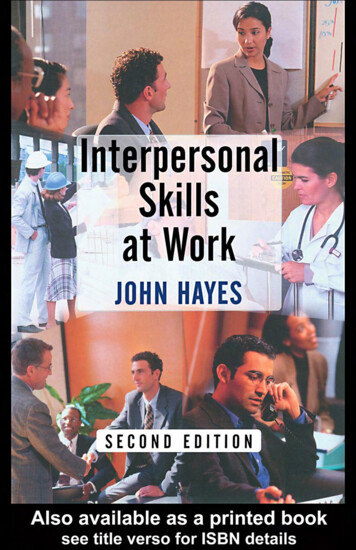
Transcription
INTERPERSONAL SKILLSAT WORKIn this age of e-business, many of us over-rely on electronic communicationand pay insufficient attention to the management of face-to-face relationships. John Hayes addresses this issue by examining the nature ofinterpersonal skills – the goal-directed behaviours that we use in face-to-faceinteractions in order to achieve desired outcomes. He argues that interpersonal competence is a key factor that distinguishes between successful andunsuccessful managers.Interpersonal Skills At Work provides a clearly structured and comprehensive overview of the interpersonal skills that are essential for effectivefunctioning at work. It presents a micro-skills approach to skill developmentthat can be used to improve interpersonal competence, as well as explainingthrough the use of illustrations and practical examples how to read theactual or potential behaviour of others around us. This knowledge can thenbe used to guide the way in which we relate to others as we learn to manageour relationships more effectively.This book will be ideal for practising managers and students of businessand management studies and psychology. The skills it promotes ensure thatit will also be of great value to a wide range of people including teachers,doctors, nurses, social workers and police officers in their everyday workingenvironment.John Hayes is Professor of Management, Associate Dean for Learning andTeaching and Director for the Centre for Organisational Behaviour Researchand Analysis (COBRA) at Leeds University Business School. He has published nine books and over sixty papers on career development, interpersonalskills, processes of change in organisations and cognitive style.
INTERPERSONAL SKILLSAT WORKSecond editionJohn Hayes
First published 2002by Routledge27 Church Road, Hove, East Sussex, BN3 2FASimultaneously published in the USA and Canadaby Routledge29 West 35th Street, New York, NY 10001Routledge is an imprint of the Taylor & Francis GroupThis edition published in the Taylor & Francis e-Library, 2005.“To purchase your own copy of this or any of Taylor & Francis or Routledge’scollection of thousands of eBooks please go to www.eBookstore.tandf.co.uk.” 2002 John HayesThe author asserts the moral right to be identified as the author of this workAll rights reserved.No part of this book may be reprinted or reproducedor utilised in any form or by any electronic, mechanical,or other means, now known or hereafter invented, includingphotocopying and recording, or in any informationstorage or retrieval system, without permissionin writing from the publishers.British Library Cataloguing-in-Publication DataA catalogue record for this book is available from the British LibraryISBN 0-203-46578-4 Master e-book ISBNISBN 0-203-77402-7 (Adobe eReader Format)ISBNs 0-415-22775-5 (hbk)ISBNs 0-415-22776-3 (pbk)
TO SARAHdaughter, friend and mentor
CONTENTSList of illustrationsPrefaceixxiii1 The nature of interpersonal skills: a historical perspective12 Developing interpersonal skills: a micro-skills approach193 Awareness of self and others and the development ofinterpersonal competence324 Listening485 Listening to non-verbal messages716 Questioning and the information-getting interview987 Presenting information to others1308 Helping and facilitating1579 Asserting and influencing20010 Negotiating22411 Working with groups25912 Managing relationships more effectively291Index301vii
110.210.310.410.511.111.2Argyle’s motor skill modelAn extended model of interpersonal interactionCognition and behaviourThe experiential learning modelHow learning occursThe six sture: interpretations of stick-figure diagramsCharacteristics of vocal expressionThe interaction between change agents andorganisational membersSeating arrangementsThe attention curveA force fieldThe helping relationshipThe non-assertive–aggressive continuumWays of responding to a situationThree-part assertion messagesSettlement not possibleOverlapping limits offer possibility for settlementThe dual concern model of motivational orientationThe integrative and distributive dimensionsThe relationship between opening bid and outcomeFrequency and duration of communicationCommunication 6201202207227227231232246267269
heelAll channelRole functions’ record sheetDimensions of interpersonal styleGroup decision-making check-listEgo statesManager to secretary: ‘Where is the telephone directory?’Secretary to manager (parallel transaction): ‘You lent itto Bob’Secretary to manager (crossed transaction): ‘How comeyou can never find things when you want ses of the five conflict modes, as reported by a group ofchief executivesContending and non-contending negotiating nition and behaviourWhat’s in a style?Reflecting on patterns of past behaviourPerception matrixEffect of our concept of self on our behaviour towards othersPreparing to listenNot attending to othersAttending to othersFollowing skillsReflecting skillsFacial expressionsInterpreting the meaning of different posturesListening to non-verbal signsCognitive scene settingInformation requirements and interview plansPlanning the schedule of questionsQuestioning and probingManaging closureAssessing the effectiveness of your interviewing styleDeveloping presentation skillsHelping style profileBench-marking effective helping behaviourEmpathic listeningGiving 27149159174183189
10.511.111.211.3Constructive confrontingMonitoring core valuesExercise consultationDiagnosing your interpersonal styleDiagnosing the need for assertive behaviourCheck-list for the acquisition and exercise of powerEffective assertingNegotiating style questionnairePlanning for a negotiationNegotiating strategyNegotiating behavioursNegotiating tacticsObserving and categorising role functionsFishbowl: Group on groupFishbowl: Individual on 8286288
PREFACEIn this age of e-business many of us over-rely on electronic communication,and pay insufficient attention to the management of face-to-face relationships. Interpersonal Skills At Work addresses this problem.Interpersonal competence depends upon our ability to understand andmanage the dynamics of social interaction. We require both diagnostic andaction skills. We need to be able to read behaviour and act in ways that willbring about desired outcomes.This book provides a clearly structured and comprehensive overview ofthe interpersonal skills required for effective functioning at work and presents a micro-skill approach to skill development. An important feature ofthe book is the inclusion of a wide range of exercises designed to help usmonitor our own behaviour, identify areas for improvement and practisenew ways of relating to others.xiii
1THE NATURE OFINTERPERSONAL SKILLSA historical perspectiveLearning objectiveTo understand the nature of interpersonal skills from a historical perspectiveand to develop a critical appreciation of the different approaches that havebeen applied to the study of social interaction.After reading this chapter you will: Be able to define interpersonal skill, and recognise that it involves the useof goal-directed behaviours to achieve desired outcomes.Be able to compare and contrast the behavioural and cognitiveapproaches to studying social interaction.Understand the difference between those behavioural approaches thatrestrict attention to observable behaviours and those behaviouralapproaches that pay attention to the intention that lies behind the behaviour.Be aware of how cognitive processes influence behaviour and how socialinteraction may be viewed as a transaction in which each interactor isseeking a satisfactory outcome.IntroductionThis chapter provides a review of the different theories and methodologiesthat have been applied to the study of interpersonal interaction. Particularattention is focused on cognitive models that view interpersonal interactionas a transaction between parties who are each seeking satisfactory outcomesfor themselves. The importance of feedback for managing and improvingperformance in response to the reactions of self and others is alsohighlighted.Chapter 2 outlines a hierarchical model of interpersonal skill and a microskills approach to training that provides the conceptual framework for theapproach to skill development presented in this book.1
INTERPERSONAL SKILLS AT WORKThe effect of behaviour on goal achievementWe spend a considerable part of our working day relating to others. One ofthe findings of the early work activity studies, echoed more recently byOshagbemi (1988), is that we consistently underestimate the amount of timewe spend in face-to-face interaction. There are also indications that we underestimate seriously the effect our behaviour has on the way others behave, andtherefore on the achievement of personal and organisational goals.Simple examples may serve to illustrate this point.Selection interviewers need to obtain from applicants as much relevantinformation as possible in order to determine which applicant will be mostsuitable for the job. To achieve this end they need to manage the interactionin a way that encourages each applicant to provide the maximum amount ofrelevant and the minimum amount of irrelevant information. This objectiveis likely to be frustrated if the interviewers do most of the talking. It will alsobe frustrated if they prevent applicants from giving full answers by overusing the kinds of questions that limit their responses to yes or no, or if theyask questions in a way that prompts them into giving the answer which theythink the interviewers want to hear.In negotiations, there is evidence that negotiators’ opening bids have animportant influence on the expectations of opponents and that this can affectthe outcome. There is also evidence that, in competitive negotiations, concessions are more likely to be reciprocated when the person offering theconcession is perceived by opponents to be in a relatively strong position. It ispossible for a negotiator to create this impression by behaving in certain ways.In decision-making groups, one of the factors which can influence thequality of a decision is the extent to which the knowledge and skills of groupmembers are applied to the task. Some of this task-relevant knowledge maynot be available to the group because some knowledgeable but non-assertivemembers of the group lack the confidence to make their views known, orbecause some members fail to pay attention or give appropriate weight to theviews of others. The person who is able to recognise what is happening, andwho can use this awareness to intervene, to act consciously in ways thatmake it more likely that relevant knowledge will be applied to the task, canmake an important contribution to improving group performance.The importance of interpersonal skillsOne of the most widely used definitions of management is getting things donethrough people. Mangham (1986) argues that a person’s success as a managerdepends upon the ability to conduct oneself in the complexity of the organisation as a subtle, insightful, incisive performer. He goes on to suggest thatsuccessful managers appear to have a natural and/or highly developed abilityto read the actual and potential behaviour of others around them and to2
A HISTORICAL PERSPECTIVEconstruct their own conduct in accordance with this reading. This is an ability we all have but, according to Mangham, ‘the most successful among usappear to do social life with a higher degree of skill than the rest of usmanage’.Interpersonal skills as goal-directed behaviours‘Interpersonal skill’ is one of a number of broadly similar terms that aresometimes used interchangeably. Other such terms include interactive skills,people skills, face-to-face skills, social skills and social competence.Argyle (1984) defines socially competent people as those who possess theskills necessary to produce desired effects on other people in social situations.These desired effects may include persuading somebody to work harder,make a purchase, make a concession in a negotiation, be impressed by one’sexpertise or support one in a crisis.Honey (1988) offers a similar definition. He refers to interactive skills asthe skills people use in face-to-face encounters to arrange their behaviour sothat it is in step with their objectives. He emphasises the point that interactive skills have very little to do with being nice or winning friends unlessthese sorts of outcomes are encapsulated in the individual’s objectives.A common theme in these definitions is the ability to behave in ways thatincrease the probability of achieving desired outcomes. It therefore seemsappropriate to define interpersonal skills as goal-directed behaviours usedin face-to-face interactions in order to bring about a desired state of affairs.Approaches to the study of interpersonal interactionThe study of interpersonal skills and interpersonal relationships is multidisciplinary and, at one level, each discipline has tended to focus attention ondifferent contexts and different kinds of relationship. In the management literature, relationships with bosses, subordinates, peers, customers and suppliersreceive considerable attention whereas in the education literature, the focus ison the teacher–pupil relationship and in the social work literature, marital,family and similar relationships tend to be the focus of attention. Berscheid(1994) observes that this has led to a situation where the matrix of interpersonal relationship knowledge is fractured along the lines of relationship type.Even within the context of a particular relationship type, the study of interpersonal skills has been influenced by a rich array of conceptual approaches.Behavioural approachesOne approach to the study of interpersonal interaction restricts attention toobservable behaviour, but there are differences even within this broadapproach.3
INTERPERSONAL SKILLS AT WORKAt one end of the scale there are investigators (e.g. Chapple 1940), whobelieve that the most important characteristic of an individual’s interactionmay be measured along a dimension of action–silence. Using a machinewhich he called an interaction chornograph, Chapple conducted many studies that were based largely on recordings of the frequency and duration ofspeeches and silences. Social scientists and trainers who have followed inChapple’s footsteps have concentrated on observing the pattern of interaction (for example, who communicates, how often, how long and withwhom) without reference to verbal or emotional content. Others haveadopted a similar approach but have also attended to the basic elements ofverbal and/or non-verbal behaviour. Duncan and Fiske (1977), for example,focus their attention on specific, immediately observable behaviours, such ashead nods and eyebrow flashes, of which the larger actions are composed.They argue that when human conduct is characterised at this relatively lowlevel of abstraction there is the advantage that observers are required to useonly the minimum of inferring.This contrasts with an alternative behavioural approach that pays attention to the intention that lies behind the behaviour and therefore requiresmore interpretation on the part of the observer. Advocates of this approachinclude Deutsch (1949), Bales (1950), Honey (1988) and Belbin (1993).Deutsch was one of the first to develop a system for categorising rolefunctions. He argued that members of an effective group must perform twokinds of function: one concerned with completing the task, and the otherwith strengthening and maintaining the group. Bales presents his approachto interaction process analysis as both a procedure for recording interactionand as a basis for assessing the characteristic ways in which different individuals participate in social interactions, for example, their approach toproblem solving.Honey argues that since any aspect of overt behaviour may be observed,it follows that all behaviour can be categorised. However, he is critical ofthose who restrict their attention to the most basic elements of observablebehaviour. He believes that while we can monitor all non-verbal behavioursuch as eyelid movements, eyebrow twitches and finger strumming, and allverbal behaviours including how frequently somebody says ‘you know’,swears and so on, this might be less useful than categorising behaviour at ahigher level. One of the highest levels of categorisation is style. A widelyaccepted definition of style is an accumulation of micro behaviours that addup to a macro judgement about a person’s typical way of communicating.Wright and Taylor (1994) refer to it as a person’s overall approach, whileHoney defines style as the conclusions we reach about the way others operate (for example, whether somebody is autocratic or participative).Recognising the need for both careful analysis and synthesis, Honey illustrates his approach to the study of interpersonal interaction with the analogyof a broken cup. If the cup were broken into only six pieces it would be4
A HISTORICAL PERSPECTIVErelatively easy to synthesise from the pieces to the whole cup. If, however, thecup were pulverised into powder it would be difficult to conclude that it wasever a cup. His approach to behaviour analysis is one which he believes facilitates both analysis and synthesis. It is based on a limited number (nine) ofbroad categories which may be used to monitor behaviour and also to provide a practical basis for planning how best to behave in the light of thesituation and the actor’s objectives. The nine categories are: seeking ideas,proposing, suggesting, building, disagreeing, supporting, difficulty stating,seeking clarification, and classifying/explaining/informing.Cognitive approachesAll of the approaches presented so far fail to pay attention to what is goingon in the actors’ heads, to what they are thinking. They restrict attention towhat people do. An alternative approach is based on the assumption that ifwe are to better understand the conduct of people in organisations we needto address what they appear to think and feel about themselves and others.Symbolic interactionists such as Mangham focus attention on the way situations are defined and the actors’ ability to think through (rehearse) how theinteraction might unfold before deciding what to do. This theme is developedin Chapter 6, when the interviewer and interviewee are presented as actorsseeking to put on a skilled performance. Cognitive approaches to the studyof social interaction place heavy emphasis on cognition as a guide tobehaviour.Exercise 1.1, presented at the end of this chapter, is designed to help youexplore the link between cognition and behaviour. It illustrates how eachactor’s intention, and the way the other actor interprets this intention, influences how the parties to an interaction behave towards each other as theinteraction unfolds.A transactional approach to social interactionSocial interaction may be viewed as a transaction in which each interactor isseeking a satisfactory outcome.The performance appraisal interview offers an example of a complex buttypical social encounter in which the behaviour of each party is influenced bythe other. The person being appraised is aware that his boss/appraiser isobserving what he is saying and doing and that on the basis of these observations she (the appraiser) is making inferences about him. These inferencesmight affect the decisions she makes about the appraisee’s pay, promotionand so on. Consequently the appraisee may not openly and honestly answerall the questions he is asked, and may attempt to manage the way heresponds in order to maximise his personal benefit from the interactionrather than to help the appraiser achieve her objectives.5
INTERPERSONAL SKILLS AT WORKThis brief description not only draws attention to the interactive nature ofsocial encounters but also to the possibility of conceptualising any interpersonal interaction as a performance which is influenced by the actors’ motivesand goals.Leary (1957) argues that people are motivated to behave towards othersin ways that elicit from them desirable kinds of behaviour that are complementary to their own. His model of interpersonal behaviour suggests thatinterpersonal acts may be categorised according to eight broad varietieswhich are related to the two factors of dominance vs. submission and hatevs. love. While we might expect any individual to be capable of displayingbehaviour across all eight categories, Leary suggests that in practice mostpeople favour some categories more than others (reflecting their personality).He also suggests that they behave in ways which elicit complementary behaviours from others. When others respond with the desired complementarybehaviour the interaction is perceived to be rewarding, whereas if theyrespond with non-complementary behaviour it is experienced as unpleasantand costly. For example, those who favour managerial-autocratic behaviours interact with others in ways that invite them to be obedient andrespectful. When others respond towards them in this way they experiencethe interaction as rewarding.Thibaut and Kelley (1959) also advance the notion of reward and cost.They conceptualise interpersonal interaction as a process of social exchange,and their basic assumption is that people voluntarily enter and stay in a relationship only so long as it is adequately satisfactory in terms of reward andcost. They evaluate the outcome of a relationship by referring to two kindsof comparison level: CL and CL-alt.The first of these comparison levels (CL) is an average of the entire population of outcomes known to a person, including those they perceive asaccruing to others as well as those they have personally experienced. Thisrepresents the neutral point on a scale of goodness vs. badness of outcome.If a relationship produces outcomes (rewards less costs) that are above thislevel, the relationship will be experienced as satisfactory.The second kind of comparison level (CL-alt) compares the outcomefrom the current relationship with the outcomes available from alternativerelationships. People may attempt to terminate or change a relationshipwhere the perceived outcomes from alternative relationships exceed theoutcomes available from the current relationship. However, if the outcomefrom the current relationship is greater than the perceived outcomes available from alternative relationships the interactor experiencing thisoutcome will be motivated to continue the relationship. This said, therewill also be involuntary relationships where the outcome from the currentrelationship is less than both the comparison level (CL) and the potentialoutcome from alternative relationships (CL-alt), but where the individualhas no option but to continue with the current (unsatisfactory)6
A HISTORICAL PERSPECTIVErelationship. For example, a prisoner may be locked into an unsatisfactoryrelationship with a cell-mate. Carson (1970) also offers an example whichillustrates this possibility in everyday life. A person may decide to remainin an unhappy marriage because, given the personal, social and economicproblems that may be associated with separation or divorce, the availablealternatives are perceived to be less rewarding or more costly than the present situation.For each member of a voluntary relationship to be motivated to interact,they must each experience outcomes from their encounters that are greaterthan their CL, and where the outcomes are greater than those they perceiveto be available through alternative relationships the existing relationship islikely to continue. All involved must see the relationship as a rewardingtransaction. Mead is reputed to have said that the secret of human exchangeis to give to the other person behaviour that is more valuable to him than itis costly to you, and to get from the other behaviour that is more valuable toyou than it is costly to him.Argyle’s social skill modelOne of the most frequently cited models of social interaction is Argyle’s(1994) social skill model (Figure 1.1). Originally developed more than thirtyyears ago, it posits that in any social encounter individuals have plans orgoals that they attempt to realise through the continuous correction of theirsocial performance in the light of the reactions of others.The sequences of behaviour that occur in social interaction are viewed asa kind of motor skill, and social performance is presented as a set of motorresponses. Just as a yachtsman can take corrective action by moving therudder, the interviewer can take corrective action when the respondent istalking too much by interrupting, asking closed questions or looking lessFigure 1.1 Argyle’s motor skill model (from Argyle, 1994, reproduced with permission from The Penguin Group).7
INTERPERSONAL SKILLS AT WORKinterested in what the respondent is saying. This model draws attention tothe importance of feedback and the perception of appropriate cues, and tothe ability to identify an effective correction routine (referred to as‘translation’ in the model). The effectiveness of social performances may varybecause, for example, not everyone knows that open-ended questions makepeople talk more and that closed questions make them talk less. Althoughthis is presented as a motor skill model, Argyle recognises that there are someaspects of social behaviour that have no immediate parallel in motor skillssuch as seeing the other person’s point of view and projecting a self-image.Argyle reports that one of the criticisms levelled against his social skillsmodel is that when people are engaged in relaxed informal ‘chat’ they do notappear to be motivated to influence or control the behaviour of others. Hisresponse to this criticism is that even in this kind of situation those concerned are trying to maintain a certain kind of interaction, and that thisinvolves the control of others’ behaviour. For example, it might involvekeeping them relaxed and happy, preventing them from leaving or from getting too serious or keeping the intimacy at the right level.Hargie (1997) has extended Argyle’s model to take more explicit accountof some of the features of social interactions, including their transactionalnature (Figure 1.2). Attention is given to: the reciprocal nature of interactions and the goals of both interactors;the fact that feedback comes from one’s own as well as the otherperson’s responses;the influence of both emotions and cognitions on perception, interpretation and the planning of responses (what Argyle refers to asFigure 1.2 An extended model of interpersonal interaction (from Hargie, 1997).8
A HISTORICAL PERSPECTIVE ‘translation’ in the original model is replaced by ‘mediating factors’ inHargie’s reformulation);the reciprocal relationship between goals and mediating factors;the influence of the person–situation context: while both people and situations are important, it is the interaction between the two that hasgreatest impact.This transactional approach to social interaction presents interpersonal skillin a way that draws attention to our ability to shape the behaviour of othersso that the rewards of interacting with them are greater than the costs. It iswholly consistent with the definition of interpersonal skills presented above,namely as goal-directed behaviours that a person uses in face-to-face interactions in order to bring about a desired state of affairs.We attempt to realise satisfactory outcomes from our interactions withothers by attending to feedback, assessing the effectiveness of our performance and continually correcting it in the light of our own assessment andthe reaction of others. Perceiving, interpreting and acting on the basis offeedback are key elements of the process of skill development. This point willbe elaborated in the next chapter.Exercise 1.1 Cognition and behaviourThe aim of this exercise is to explore the link between cognition (whatpeople are thinking) and behaviour. It involves deciding, on a step-by-stepbasis, how each party may react to how the other person behaves.The interactive nature of relationships is illustrated in Figure 1.3. Thisdiagram illustrates how each actor’s intention, and the way the otheractor interprets this intention, influences how the parties behave towardseach other as the interaction unfolds.The questions listed in the cognition ‘bubbles’ in Figure 1.3 suggest thekinds of things the actors might be thinking about during the interaction.This process is elaborated on in the following pages, but you may needto refer to Figure 1.3 as you work through the exercise.MethodYou can complete the exercise working alone or with another person.The exercise format presented here is for use by two people workingtogether. However, it can be easily adapted for use by one person. Simplyassume the role of A and B in turn and reflect on how each party mightinterpret the behaviour of the other and what effect this is likely to have on9
INTERPERSONAL SKILLS AT WORKFigure 1.3 Cognition and behaviour.10
A HISTORICAL PERSPECTIVEhow the relationship develops. Fill out the cognition ‘bubbles’ and behaviourboxes for both parties (A and B). After you have completed severalexchanges, reflect on how interpretation of intent can influence behaviour.If you decide to complete this exercise by working with anotherperson, decide who will be A and who will be B.ContextThe context is a fina
Interpersonal Skills At Work provides a clearly structured and compre-hensive overview of the interpersonal skills that are essential for effective functioning at work. It presents a micro-skills ap
